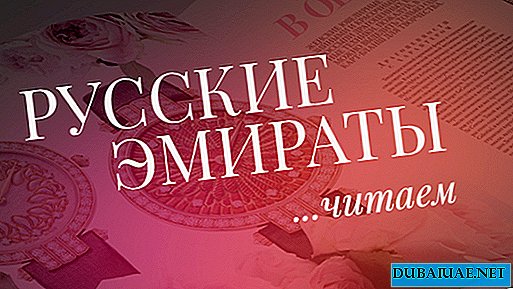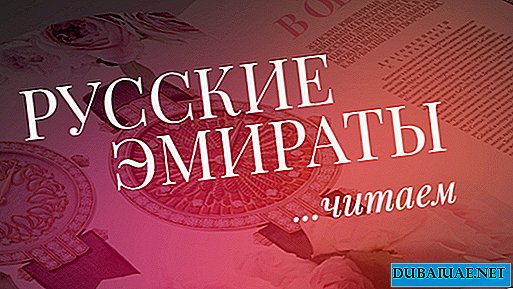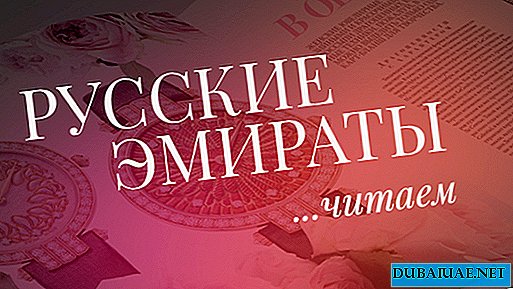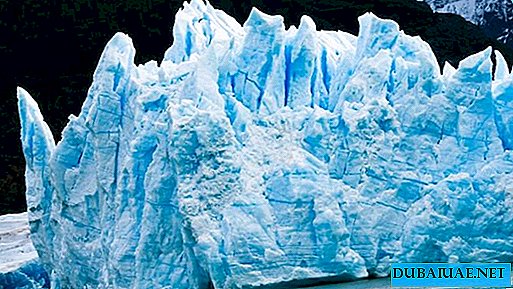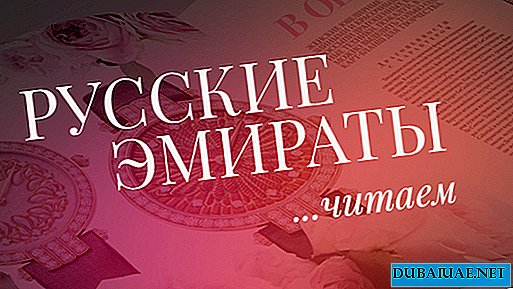This was perhaps the most colorful, interesting and most visited event of the year. The traditional September exhibition "Hunting and Horse Breeding Abu Dhabi 2005" this year overshadowed all the holidays of hunters and nature lovers, held in the Emirate capital earlier. It was the main event of the second decade of the first autumn month, when the metropolitan society is gradually reviving to an active life after the summer "dead season".
The hot weather, which continued to “soar” the residents of the capital, did not prevent the gathering of all the colors of the emirate’s society at the opening of a hunting celebration in the main Exhibition Center in Abu Dhabi. Despite the presence of the sons of Sheikh Zayed, other influential sheikhs, ministers, foreign ambassadors and “very important people” who came from neighboring states, there was no organization, the atmosphere was friendly and respectful, the formalities of accrediting journalists were overcome with elegant courtesy at a high technological level.

On the duty of his chairmanship in the Emirate Falconry Club, the celebration marking the beginning of the hotel season in the region was opened by Deputy Prime Minister Sheikh Hamdan bin Zayed Al Nahyan. The exposition almost doubled the scale of a similar event last year in terms of the size of the space occupied and the number of participants. Their hunting birds, horses, camels, dogs, bustards bred at home, as well as hunting equipment were shown on 11 thousand square meters. meters 36 countries, including about a dozen Arab. Among the exhibits were all kinds of saddles, stirrups, a bit, a bridle, a girth, shotguns, pistols, including laser ones; binoculars, blades of various designs, lights, installations for drinking water and even nature-friendly toilets in elegant tent tents. Of particular interest to visitors was a mastodon truck used for hunting by Saudi princes. Elegant camouflage clothing and many original inventions, invented to satisfy the primitive interest that remained in the blood of contemporaries, were pleasing to the eye.
The number of exhibitors exceeded three and a half hundred companies. The number of visitors was tens of thousands. Particular attention was drawn to the event by the personal participation of the Emirate President Sheikh Khalifa bin Zayed Al Nahyan. His first center in the Middle East, ProFalCon, has been breeding hunting falcons for about 10 years, and has put 260 of its pets bred here this year.

According to information received by the author of these lines from participants in a unique show, Russian specialists work in the center along with other foreigners. True, the ProFalCon pavilion, beautifully decorated in the form of a medieval Arab fortress, did not have representatives from Russia. Only the fruits of their zeal were shown.
At the first auction of horses and camels, the descendants of Russian thoroughbred Arabian horses were displayed along with other lots. The eyes and ears were caressed by the Russian nicknames of horses once known in Russia, which were recorded in the trading bulletins and pronounced from the podium, which were included in the biographies of young emirate prancing beauties. In their incomplete list: Moscow, Lightning, Olive, Medusa, Heir, Naphthalene, Hint, Tender, Desert, Songbook, Plasma, Orphan, Taiga, Tallinn, Cheryomysh, Bookcase, Emigrant, Emigrant and fate, Patriot fell into their company.
At least five descendants of the famous Arabian horse Aswan, donated to the Soviet government by the late Egyptian President Gamal Abdel Nasser in the 60s at the peak of Soviet-Egyptian friendship, were put up for auction.
Aswan, gratefully received by Moscow, was kept at the world famous Tersky stud farm and served to the glory of the Soviet stables. His daughter Plasma and some other younger relatives, for economic reasons caused by political circumstances, continued their life on the farms of the founder of the Emirate state, Sheikh Zayed. They contributed to the improvement of the local herd of Arabian horses, distinguished among horses of other breeds not only by their character and remarkable properties, but also by their morphological peculiarity - they have one less vertebra in their vertebral column than other wind-drinking horses. It is believed that due to this natural difference, their backs are stronger and more comfortable for riders.

A 20-year-old granddaughter of Aswan and Karta was put up for auction - a gray mare of Kenya and her younger relatives - grandchildren of Taiga, great-grandchildren of Aswan and Teplitsa, an 8-year-old chestnut stallion Rabadan and seven-year-old Sanikh bay. Among the younger successors of the Aswan breed, the daughter of Panagia, the one-year-old gray mare Barsha, and the two-year-old great-grandson of Aswan and the Desert, Shadid, were sold at auction.
Lot prices are known. Those who wish can inquire about them from the organizers of the auction, which took place in a very pleasant atmosphere. Announcements were duplicated in Arabic and English. Tea in glass cups was distributed among the audience. Beautiful horses pranced in front of the stands on a sawdust-covered podium, neighing uneasily and making racks.
Despite the popularity of bidding, in which up to 60 people participated daily, prices were acceptable. The most expensive lot was the Sabab stallion, which in the process of intense competition between bidders was valued at 100 thousand dirhams. The cheapest horse auctioned among 112 others went to the buyer for only 6 thousand dirhams.
The director general of the Emirate Arabian Horse Society, Isam Abdullah, whom I met at the auction, said that in a few days he was going to the Russian capital to participate in the closing of the Moscow racing season. The event, with the participation of purebred Arabian and riding horses, was held in Moscow on the third Sunday of September. For the first time, the UAE sponsored all the traditional prizes of the largest event of the Moscow racing season. This action of the emirates testifies to their great interest in the Moscow races. Isam Abdullah said that in recent years the UAE Equestrian and Racing Federation has provided financial support to the main competitions of Arabian horses in some countries of Europe, Africa and the USA. Since this year, Russia has been included in the list in order to promote the development of horse breeding and the further popularization of Arabian horses.

Arabs claim to be the first to tame a horse, but their whole life has been associated with camels for centuries. They love good horses, celebrate their nobleness and devotion, but retain a hot attachment to the obstinate and arrogant "caravels of the desert."
For the first time in the world, an auction of camels at the exhibition showed that for local Arabs, a humpbacked desert all-terrain vehicle is more expensive than a horse, and they are ready to give for it not the fabulous kingdoms, but the whole kingdom.
Following one trading day, 29 camels were sold for 2.4 million dirhams. The cost of 49 horses sold was only 100 thousand dirhams more. The most expensive camel lot was 12 and 200 times more expensive, respectively, than the most expensive and cheapest horses sold at auction.
One million 200 thousand dirhams (approximately 327 thousand dollars) was paid for by a camel bought by one of the grandchildren of the founder of the Emirate state, Sheikh Zayed. Sheikh Mohammed bin Hamdan, the son of Vice Premier who was fond of camel racing, did not spare money for a representative of the Jabbar breed, the most popular breed in the country and in the Gulf, which was included in pedigree books and was preferably used in the Emirates to build camel stock. For almost the same amount of money, Sheikh Mohammed bought seven more camels, which had not yet become famous, as the first, which had already become the winner of several races in Abu Dhabi and Dubai.
A camel auction in the capital was the first successful experience of this kind. Usually, camel sales in the countries of the Arabian Peninsula take place after a series of races organized mainly in the UAE, Oman and Saudi Arabia. Above all, Omani running camels with rich pedigrees are listed. The cost of prize-winners of competitions exceeds, as a rule, the prices of expensive cars of the best world brands and is at the level of 150-200 thousand dollars. From time to time on the Arabian market, fantastic price rises occur due to the appearance of bright stars on the sand tracks. This was the case several years ago, the six-year-old Kuwaiti record holder Ifrita (Devil), which was sold for 420 thousand dollars.
 According to 2001 data, there are approximately 120 thousand camels in the UAE. In the free pasture of unpretentious conquerors of deserts, very few remained. They are located mainly in corrals, near oases and cities. The number of camel breeders is unknown. It can be assumed that it amounts to several thousand.
According to 2001 data, there are approximately 120 thousand camels in the UAE. In the free pasture of unpretentious conquerors of deserts, very few remained. They are located mainly in corrals, near oases and cities. The number of camel breeders is unknown. It can be assumed that it amounts to several thousand.
The falcons in statistics are more fortunate. About 3,000 emirates keep birds of prey. At least 8,000 falcons have passports, without which falconers cannot export their helpers abroad during the pursuit of migratory flocks.
Falcons do not stray in flocks, but the falconry “wedding” gathered at the exhibition totaled more than 1000 of these strict, concentrated, beautiful birds. They sat on the shelves near a stuffed giant elephant and dummies of a lion family, next to the corral of white-pink puppies with an Arabian saluki greyhound. Some exhibitors wandered around tents, salons and pavilions with falcons in their hands, offering their goods to interested people. The falcons took the exhibition "full." They weren’t except near the large cells with anxious bustards. The bulky and awkward desert members of the chicken family looked alarmed and restless anyway.
Among the suppliers of feathered hunters were Russian. The Altai falconer Konstantin Pyatkov brought 100 peregrine falcons, balabans and gyrfalcons to Abu Dhabi. The 43-year-old director of the largest Altai-Falcon nursery in Russia, where about one and a half hundred falcons are bred annually, has been cooperating with emirate lovers for about 10 years. He participated in the exposition for the second time and, in an interview with the journal correspondent, noted a tendency to expand ties and procurement.
30-year-old Muscovite Nadezhda Mikhailova represented the Sapsan Foundation, a regional public organization for the protection of rare birds, at the exhibition. The Russians expressed satisfaction with the organization of the exposition. They were fascinated by the festive atmosphere of the hunting show, where artists showed sketches of hunting paintings, portraits of falconers and their hunting feathered friends, poets competed in reading poems on hunting topics. It was, indeed, a holiday accompanied by folk songs and dances.
Victor Lebedev




